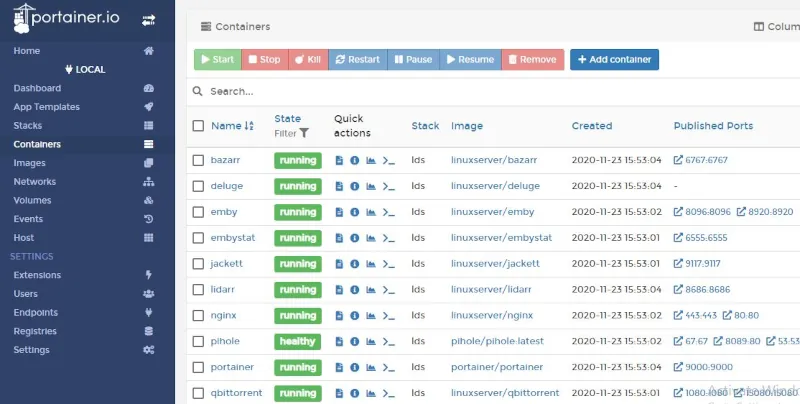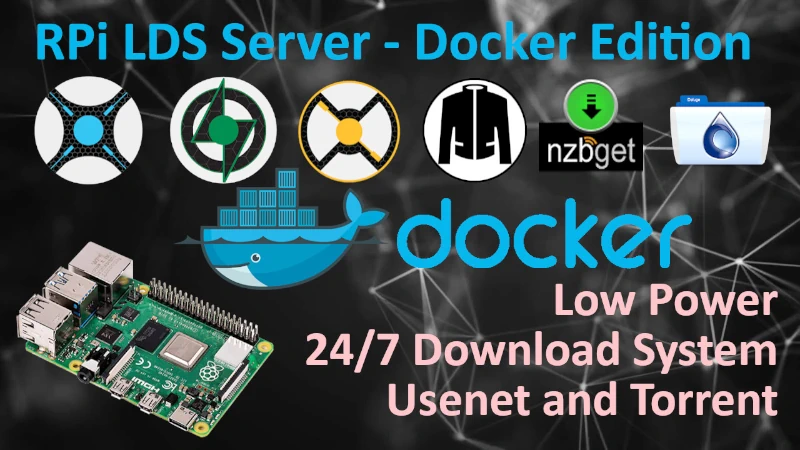How to deploy LMDS?
install Git:
sudo apt-get install gitClone LMDS repository:
git clone https://github.com/GreenFrogSB/LMDS.git ~/LMDSDo not change name of the folder on your local system, it should stay as is for the script to work properly
Enter the directory and run:
cd ~/LMDS./deploy.sh- First
Install Docker & Docker-compose - Second
Build LMDS Stackby selecting containers to deploy. - Configure containers you deploy by pointing your browser at the LMDS IP address, followed by the port number of the container.
- Explore other options in the menu and visit FAQ for more advanced instructions.

LMDS containers and their ports:
- Portainer - Web UI Docker Manager :9000
- Sonarr - Content Manager (TV Shows) :8989
- Radarr - Content Manager (Movies) :7878
- Lidarr - Content Manager (Music) :8686
- Bazarr - Subtitles Manager :6767
- Jackett - Torrent Socket :9117
- Prowlarr - Jackett alternative (dev) :9696
- Deluge - Torrent Client :8112
- qBittorrent - Torrent Client :15080
- Transmission - Torrent Client :9091
- NZBGet - Usenet Client :6789
- SABznbd - Usenet Client :8080
- JellyFin - Media Manager OpenSource :8096
- Emby - Media Manager :8096
- Plex - Media Manager :32400/web
- EmbyStat - Statistics for Emby :6555
- TVheadend - TV streaming server :9981
- Pi-Hole - Private DNS sinkhole :8089 WebPass: greenfrog
- WebServer - NGINX + PHP + MariaDB + phpMyAdmin :60101 / 60102
- VPN-Client - OpenVPN Client/Gateway
- Traefik 2 - Reverse Proxy
Numbers after ":" identify a port that particular container will respond on, i.e. Portainer default port is :9000, point your browser at LMDS server IP:PORT in order to see Portainer login page.
https://SERVER-IP:9000

All the Docker containers are being created by docker-compose.yml file – this file is updated each time you lunch deploy.sh script where all depend from selection you make in the menu. This docker-compose file can be found inside LMDS folder after first successful deployment. You can edit it manually if you know what you are doing or keep lunching deploy.sh script and selecting/deselecting containers there.
After deployment is completed all the containers settings are stored in persistent volumes inside ~/LMDS/volumes/ folder, keep this folder safe - all configuration you make for the containers using Web GUI are stored there. If you want to factory reset a container, stop it, delete container instance and then delete relevant folder from within ~/LMDS/volumes/, then deploy container again. This will recreate folder you just deleted but with default container settings as if that container never existed before.
Containers can be deleted and recreated or modified; you can do this by editing docker-compose file and running docker-compose up -d. You can also do some changes to the containers using Portainer GUI if this is more convenient.
Get yourself familiar with docker-compose.yml file. This file will tell you which folders/volumes are mapped to which container, this knowledge will allow you to better understand where data should be kept and from where containers can read them. Knowing above you could map your remote storage to particular folder and then present it to the container rather than storing all media files on RPi SD card.
Help me make LMDS better
With your support anything is possible
- Beginner
- Objectives
- Concept
- Hardware
- Hypervisor
- Hypervisor Manager
- Hypervisor Initial Config to be continued...
- Advanced
- My Quiet Lab
- Active
- Depreciated


